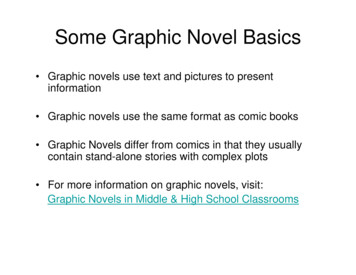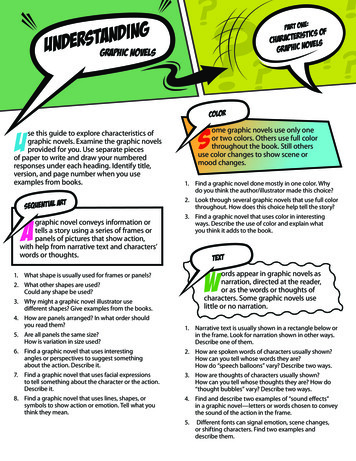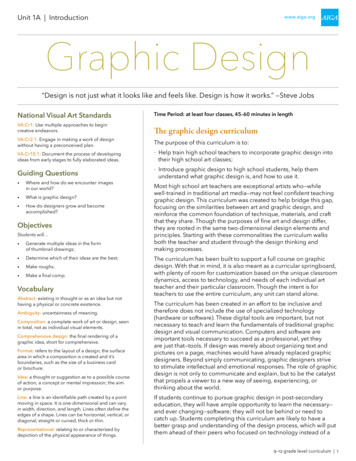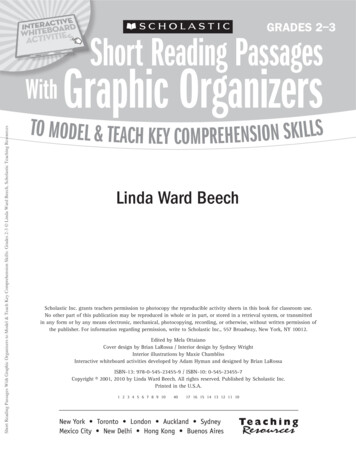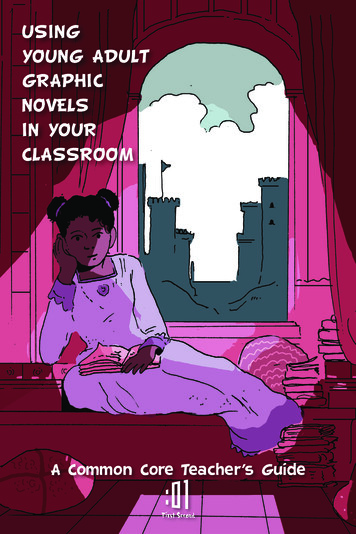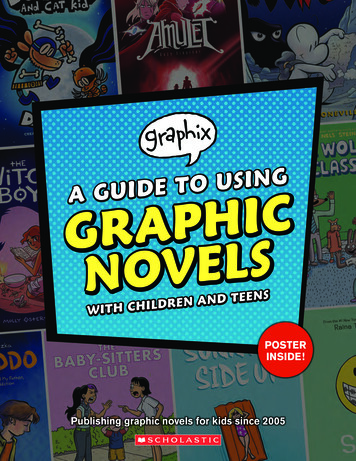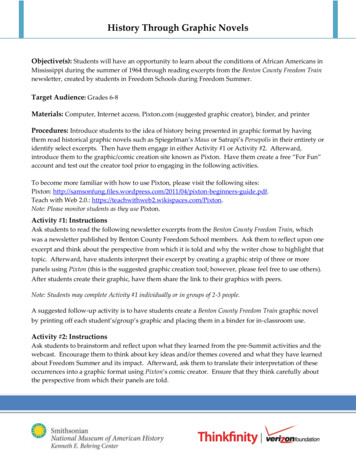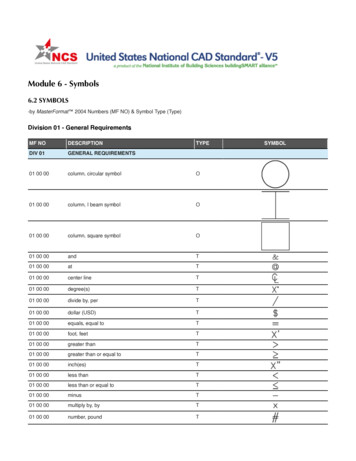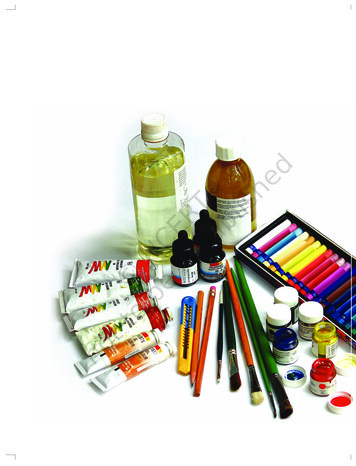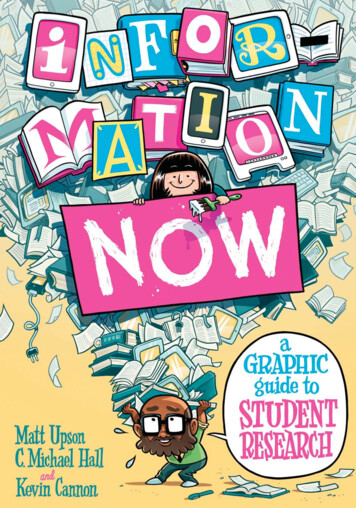
Transcription
This document is designed to assist North Carolina educators in effective instruction of the new Common Core State and/or North CarolinaEssential Standards (Standard Course of Study) in order to increase student achievement. NCDPI staff are continually updating and improvinginstructional tools to better serve teachers. These Graphic Organizers are in draft form and are undergoing review for feedback.Graphic Organizers SAMPLESWhat is the purpose of this tool?These visual representations assist the student in organizing abstract “big picture” information that is new, overwhelming or misunderstood. Researchsupports the utilization of graphic organizers as a contributing factor in improving student performance. The examples are to model varied organizersand their use in provoking student engagement, organization, and understanding, thus equipping the teacher with the knowledge to develop and usesuch tools effectively with the new standards. By providing these examples, DPI is creating a foundation for teachers to shift the focus from merelyclassroom instruction, but also on student learning.What is in the tool? The instructional tool uses straightforward (clear) models/examples that can be used in the classroom in alignment with the newstandards. The tool speaks directly to teachers and holds high expectations for teachers’ ability to understand the use of the tool as a mechanism fordifferentiating instruction.How do I send Feedback?We intend the explanations and examples in this document to be helpful and specific. That said, we believe that as this document is used, teachers andeducators will find ways in which the tool can be improved and made even more useful. Please send feedback to us at feedback@dpi.nc.gov and we willuse your input to refine our instructional tool. Thank You!Where are the new Common Core State and North Carolina Essential Standards?All standards are located at http://www.ncpublicschools.org/acre/standards/
Global Systems ChangeOrganisms are linked to one another and to their environment by the flow of energyand cycling of matter. Acquisition of resources and population growth can acceleratethe rates of natural change in a system.Figure 1. Mr. Green Gene’s Farm Key Terms:All Living ThingsCarbon CompoundsChemosynthesisChemosyntheticbacteriaCO2 in airCarnivoresCoal, Oil, Natural gasDeathDecomposersDecrease CO2 in airExcretionFossil FuelsGlobal TemperatureGreen PlantsGreenhouse effectHerbivoresIncrease in CO2 in airLocal air temperatureOmnivoresOrganic MatterPhotosynthesisRespirationhay
. Teacher NotesConcept MappingDesigning a concept mapping activityConcept mapping is one way to organize information that serves as a visual tool for learners. Conceptmaps may be used to show how science topics and ideas are related; thus, they are vital to effectivescience teaching and meaningful learning. Maps may be generated to flow from a central concept, topicor process. Lines or arrows are used to show how the different parts of a concept are related flowing froma general to a more specific idea.Concept maps are excellent formative and summative assessment tools for eliciting evidence of howstudents organize, connect and synthesize information. Maps generated by students are most effective inaffirming evidence of learning; however, differentiation may be accomplished by presenting students withpartially completed maps. While there are many ways to construct concept maps (no one way receivingpreference to another), students should be given general rules that may serve as success criteria.The following is an example of how to design a concept map activity. This is an activity that may be usedwith a unit on human influences on the environment. While it is intended for use in a high school biologyclass, portions may be adapted for use in middle or upper elementary school. The scope and sequencechart in figure 2 will assist you in identifying the appropriate NC Science Essential Standards that may beaddressed. Figures 3-8 are examples of concept maps that connect many ideas around carbon cycling, amajor factor of climate change. Figures 9 - 11 are examples to explore student ideas about living and nonliving things.Please refer to the references provided for more information on the use of concept mapping in thescience classroom.Step 1 – Select key terms. Identify the most critical terms related to the concepts in a unit then constructpropositions, pairs of connected terms, which indicate what you have determined you want students toknow and be able to express at a meaningful level at the end of the learning experience.Step 2 – Determine where to embed the map. Concept maps may be used as a pre-assessment tool. Animportant feature of concept maps is the ability to revise as the instruction continues. Thus, conceptmapping activities should be planned at critical points to help inform instruction.Step 3 – Create the activity. Open-ended construct-a-map activities provide the greatest insight intostudent understanding of a concept. Provide students with the opportunity to create their own map first;then, share ideas in small groups and to the whole class. Once feedback has been provided andinstruction proceeds, students should have the opportunity to redraw their concept map to demonstratechanges in their understanding of the concept. When used in this manner, concept maps are both a selfteaching tool and a diagnostic tool.Sample Activity:Elicit evidence of prior knowledge.Figure 1 is a conceptual model of factors affecting Global Systems Change. Human influences on climate change oftenspark debate among individuals in various arenas of society. Scientists and politicians currently debate the phenomenaof climate change and global warming. Not all scientists agree about the prospects of human influences on climatechange and global warming nor do all policy makers agree on what to do about it. What do you think about climatechange and global warming?Students’ task: Your task is to examine figure 1 and the associated key terms. Create a concept map about your ideason human influences on Earth’s climate. Your concept map should show your ideas about the effects of human activitieson climate and the Earth as a system.1. Start with the phrase “all living things” at the top.2. Use arrows and linking phrases to connect ideas.3. Use each key idea only once.
Addressing English Language Learners:To meet the needs of English Language Learners in science classes embed English LanguageDevelopment Standard 4: English language learners communicate information, ideas and conceptsnecessary for academic success in the content area of Science. Consider teaching these graphicorganizers in parts, adding on more components as students demonstrate comprehensibility. Engage ELLs in the use of academic language in all 4 language domains: listening, speaking,reading, and writing through partner and small group activities. Oral academic languagedevelopment is essential to build reading and writing skills. Explicitly teach vocabulary before, during, and after a lesson. Besides key terms listed for figure 1teach such words as frequency, salinity (saline), accumulation, sea level rise, sedimentation(sediment), deposition, variation (vary), urban sprawl.o Orally pre-teach vocabulary using these steps. Activity should take from 2-5 minutes. Teacher says the word/phrase. Students repeat the word 3 times. Teacher uses the word in context from the text/diagram Teacher provides the dictionary definition (students do not find the word in thedictionary) Teacher explains meaning of words with student-friendly definitions Teacher engages students in speaking activities to develop word/conceptknowledge Teacher points out grammar, multiple meanings, spelling/pronunciationanomalies associated with word Link graphic organizer/reading to students’ background knowledge or build backgroundknowledge Employ partner reading to build comprehension.o Teacher uses “think aloud” to model the partner reading process.o Students, in partners, read the graphic organizers/reading passage and summarize whatthey have read. Students begin partner reading by alternating reading and summarizingsentences. Then partners alternate reading and summarizing paragraphs.o Note the students’ discourse complexity and their use of key vocabulary in theirsummarization as a means for ongoing assessment to plan specific interventions to meetindividual needs. Provide cooperative learning activities during the different stages of the writing process.o Student group explains a process Each student in the group copies the prompt on a piece of paper, completes thesentence, and passes to paper to the right. That student reads what was written, writes another sentence, and passes thepaper to the right. The process continues with each student reading the previously writtensentences and adding another sentence to each paper he/she receives until theteacher calls time.
Connections of NC Science Essential Standards and Common Core State Standards for Literacyin ScienceBio 2.2 Understand the impact of human activities on the environment (one generation affects the next).Range of Reading and Level of Text Complexity (Grades 9-10) By the end of grade 10, read andcomprehend science/technical texts in the grades 9–10 text complexity band independently andproficiently.Range of Writing (Grades 9-10) Write routinely over extended time frames (time for reflection andrevision) and shorter timeframes (a single sitting or a day or two) for a range of discipline-specific tasks,purposes, and audiences.Figure 2.BiologyBio.2.1Interdependence ofLiving things and theEnvironmentBio.2.2Human Influence ontheEnvironment2.E.1Patterns ofweather and theeffects of the sun’senergy on theland, air and water8.L.3InterdependenceofOrganisms withbiotic and abioticfactors of theenvironment5.L.2Interdependenceof plants andanimals her andclimate & theeffects of theatmosphere onhumans4.L.1Effects ofenvironmentalchanges on livingthings(adaptation andvariation)1.L.1Behavior oforganisms/Survival in variousenvironments3.L.2Survival of plantsIn theirenvironmentK.L.1Characteristics ofLiving andNon-livingThings6.L.2Flow of energythrough anecosystem(Response tobiotic & abioticfactors)
Figure 3. Sample Concept Map of Carbon CyclingOrganisms are linked to one another and to their environment by the flow of energy and cycling of matter.Acquisition of Resources and Population Growth can accelerate the rates of natural change in a system.GlobalTemperatureDecrease in CO2in airleads toChemosynthesisleads toOmnivoresPhotosynthesiscarry outcarry outChemosyntheticbacteriaGreen plantsare eaten byDecomposersCarnivoresHerbivoresincludesALLLiving thingscarry outreleasesCO2 in airRespirationExcretionDeathProduceswasteproduces deadOrganicmattercauses anis mainlyIncrease inCO2 in airCarbonCompoundscausesaredecomposedbychanged underhigh pressure toGreenhouseeffectincreasesaffectscarry outwillexperienceFossilfuelsLocal AirTemperatureincluderelease duringcombustionCoal, Oil &Natural gas
Figure 4. Sample Concept Map of Carbon Cycling in socio-ecologicalEnduring Understandings:Human Impact: Acquisition of resources and population growth can accelerate the rates ofnatural change in a system.CO2 emissions,DeforestationAtmosphere (PhysicalSystems)(composition of air,atmospheric CO2)Generation oforganic carbon&harnessingenergy(photosynthesis)Oxidation ofOrganic carbon &energy dissipating(respiration,combustionMovement of organic carbon &passing on energyBiosphere (Biological Systems)Food &Fuels(Food chains, growth & weight loss,carbon sequestration, organic carbon)Environmental system services: Organisms are linked to one another and to theirenvironment by the flow of energy and the cycling of matter.Mohen, Lindsey, Jing Cheng, and Charles W. Anderson. (2007, July). Developing a K-12 Learning Progression forCarbon Cycling in Socio-Ecological Systems presented at the Knowledge Sharing Institute of the Center forCurriculum Studies in Science. Washington, D.C.
Figure 5. Sample Concept Map of Carbon CyclingOrganisms are linked to one another and to their environment by the flow of energy and cycling ofmatter. Acquisition of Resources and Population Growth can accelerate the rates of naturalchange in a system.causes an
Grade 9-10By the end of grade 10, read and comprehend science/technical texts in the grades 9–10 text complexityband independently and proficiently.Reading Assignment:Analyze a reading passage and determine how human activities might impact the environment.Essential Question:How do scientists model and predict the effects of human activities on Earth’s climate? Key Ideasand Details Biology:Analyze aReading PassageHuman Influenceson theEnvironment Craft andStructure Integration ofKnowledge andIdeas Cite specific textual evidence to support analysis of science and technicaltexts, attending to the precise details of explanations or descriptions.Determine the central ideas or conclusions of a text; trace the text’sexplanation or depiction of a complex process, phenomenon, or concept;provide an accurate summary of the text.Follow precisely a complex multistep procedure when carrying outexperiments, taking measurements, or performing technical tasks, attendingto special cases or exceptions defined in the text.Determine the meaning of symbols, key terms, and other domainspecific words and phrases as they are used in a specific scientific ortechnical context relevant to grades 9–10 texts and topics.Analyze the structure of the relationships among concepts in a text,including relationships among key terms (e.g., force, friction, reactionforce, energy).Analyze the author’s purpose in providing an explanation, describing aprocedure, or discussing an experiment in a text, defining the questionthe author seeks to address.Translate quantitative or technical information expressed in words in a text intovisual form (e.g., a table or chart) and translate information expressed visuallyor mathematically (e.g., in an equation) into words.Assess the extent to which the reasoning and evidence in a text support theauthor’s claim or a recommendation for solving a scientific or technical problem.Compare and contrast findings presented in a text to those from other sources(including their own experiments), noting when the findings support or contradictprevious explanations or accounts.
Bio2.2Human Influences on the EnvironmentLong-term Writing TaskEnvironmental Problem:Choose a problem that can beattributed to human influence.Human Impact:Give examples of how humanshave caused the problem. Provideevidence from your research.A: Global Atmospheric WarmingorB: Warming of OceansEvidence tosupport AConclusion:Summarize yourfindings. Stateyour conclusion.Describe theproblem(cause & effect)Evidence tosupport BExpertReportSolutions:Present one or more possibleways to solve the e the longterm effectsEffectImplications:Cite the longterm effectsEffectImplications:Cite the longterm effectsShort-term writing prompt:a. Argument: Should the acquisition and preservation of undeveloped land be a priority for our state? If so, what could youdo personally? If not, why not?b. Expository: Explain how scientists monitor the environment to detect ecosystem changes and provide reasons why it isdifficult to predict how a particular ecosystem might react to a change in climate.
Bio2.2Human Influences on theEnvironment(Embed Information &Technology Standards)Sources of Information:HS.SI.1 Evaluate resourcesneeded to solve a givenproblem.Environmental Problem:Choose a problem that can beattributed to human influence.Technology as a Tool:HS.TT.1 Use technologyand other resources forassigned tasks.Human Impact:Give examples of how humanshave caused the problem.Provide evidence from yourresearch.Research Process:HS.RP.1 Design projectbased products thataddress global problems.Solutions:Present one or more possibleways to solve the problem.Safety and Ethical Issues:HS.SE.1Analyze issues andpractices of responsiblebehavior when usingresources.Conclusion:Summarize your findings.State your conclusion.Teacher’s Task: Review the Information and Technology Standards. Brainstorm ideas for embedding the standards into the researchassignment.
AllLiving ThingsincludesCO2 in airFigure 6. Upper Elementary/Middle SchoolSample Concept Map ofCarbon and Oxygen CyclingDecomposersconsumersproducerscaptureare eatenbyCarnivoresHerbivoresGreen plantsOmnivoressunlightprovidesenergy chreleaseswhich isused kdownwhichreleasesdecomposersin air & soilalsousedbyoxygenwhichis used foranimalrespiration
Figure 7. Elementary Sample Concept Map ofCarbon and Oxygen CyclingCO2 in airhawkAllLiving Thingsbacteriafieldmiceincludesare eatenbyare eatenbyacornsproducersis treewhichdecreasesprovidesenergy forplantphotosynthesiswhichreleaseswhich isused nalsousedbywhichis used for
Figure 8. Grades 5-8 Sample Concept MapComponents of an EcosystemMr. Green Gene’s farm is home to many living and non-living things that are busy interacting every day. Analyze figure 1 andmake a concept map that identifies the living and non-living components of Mr. Green Gene’s farm. Start with the wordecosystems at the top. After completing your concept map, tell how the non-living things are beneficial to the living things andhow the living things are beneficial to each other. Make a diagram of a food web (lower grades: food chain) that includes Mr.Green Gene. Identify the producers, herbivores, carnivores, omnivores, and decomposers for your food web. See Appendix A foranimal dentify theproducers on Mr.Green Gene’s FarmincludeAnimalsthat only eat plantsconsumersincludeAnimals:Identify the animalson Mr. Green Gene’sFarmSort Mr. GreenGene’s animals into3 groups:includeAnimalsthat eat other ganismssuch asbacteria, and fungiincludeAnimalsthat eat plants andother living animals sunlightairsoilwater
Figure 9 Grades 3-5Needs of Living OrganismsOrganisms survive best in environments where their needs are met. All living things need food for energy, growth and repair of the body.Plants and animals depend upon the resources and conditions of their habitats to survive. Mr. Green Gene depends on many of the livingand non-living things on his farm to survive. But, is it all food? Analyze figure 1 and make a concept map that demonstrates your ideasabout the needs of living organisms. Include your thoughts about food. Start with the phrase “needs of living organisms” at the top andinclude ways to sort materials that maybe considered food. See Appendix B for card sorting activity.Needs of LivingOrganismsincludematternon-matterhas 2propertiesmaybesorted asexamplesincludeexercisemass(weight)(volume)takes upspacefoodmaterials thatprovide chemicalenergythingswe eatmaybesorted asnot-foodmaterials thatdo not providechemical energymaybesorted assolidtightly packedmaterials thatslightly move &maintaintheir own shapewarmththingswe usemaybesorted asliquidloosely packedmaterials thatflow downward &take the shapeof the containerthey are ingasnaturalloosely packedmaterials thatconstantly move untilthey completelyfill the shape ofany containerthey are inmanmade
Figure 10. K-3 Sample Concept MapLiving vs. Non-living ThingsAll living things need food for energy, growth and for repair of their bodies. Plants and animalsdepend upon the resources and conditions of their habitats to survive. Mr. Green Genedepends on many of the living and non-living things on his farm to survive. Identify pictures ofthings that may be found on Mr. Green Gene’s farm. Cut out the pictures and sort them as“living” or “non-living”. Explain why you have placed each picture in its group.(See Appendix C for sample pictures. Combine the animals from Appendix A for greatervariety.)Living ThingsNon-living Things
Figure 11. Grades K-3 Sample Concept MapLiving vs. Non-living ThingsThere are some characteristics that all living things share that make them different from nonliving things. On the other hand, there are some characteristics that are the same for livingand non-living things. For each characteristic listed, tell if it describes living things only, nonliving things only or both. Write the number of each characteristic in the appropriate place onthe diagram. Explain why you made each choice.LivingNon-living ThingsBoth1. Uses energy from theenvironment2. Reproduce3. Grow and develop4. Show movement5. Breathe6. Remove waste7. Respond to their environmentInterdependence of Living and Non-living ThingsJustified Memory GameMake at least 3 sets of the “Living and Non-living Things” cards. Turn all ofthe cards face down. Students make pairs of exact matches or of a livingor non-ling thing and its source of energy. For example, a student maymake a pair of two trucks or a truck and gasoline, as gasoline is a sourceof energy for the truck. Or, a student may pair two rabbits or a rabbit anda carrot. Students must tell why they are matching two cards that are notalike. (Use cards found in appendices A and C.)
Sample Activity Modified:Pre- scripted Post-it Notes: Pre-scripted post-it notes and pictures may be used to help students withlearning disabilities or those who need more assistance with vocabulary. (Appendix D)Elicit evidence of prior knowledge.Figure 1 is a conceptual model of factors affecting Global Systems Change. Human influences on climate change oftenspark debate among individuals in various arenas of society. Scientists and politicians currently debate the phenomenaof climate change and global warming. Not all scientists agree about the prospects of human influences on climatechange and global warming nor do all policy makers agree on what to do about it. What do you think about climatechange and global warming?Students’ task: Your task is to examine figure 1 and the associated key terms. Create a concept map about your ideason human influences on Earth’s climate. Your concept map should show your ideas about the effects of human activitieson climate and the Earth as a system.1. Start with the phrase “all living things” at the top.2. Use arrows and linking phrases to connect ideas printed on the post-it note.3. Use each key idea only once.References:American Association for the Advancement of Science (AAAS). 1993. Benchmarks for science literacy.New York: Oxford Press.American Association for the Advancement of Science (AAAS). 2001. Atlas of Science Literacy.Washington DC: AAAS.Keeley, Page, F. Eberle, and C. Dorsey. 2008. Uncovering student ideas in science: Another 25Formative Assessment Probes (vol.3). Arlington, VA: NSTA Press.Mohen, Lindsey, Jing Cheng, and Charles W. Anderson. (2007, July). Developing a K-12 LearningProgression for Carbon Cycling in Socio-Ecological Systems presented at the Knowledge SharingInstitute of the Center for Curriculum Studies in Science. Washington, D.C.Vanides, Jim, Yin Yue, Miki Tomita and Maria Araceli Ruiz-Primo. 2005. Using Concept Maps in theScience Classroom. Science Scope 28 (8): 27– 31.Concept-mapping Resources:For more examples of grade level concept maps, visit the Science Wiki:: http://www.ncdpi.wikispaces.netSoftwareInspiration www.inspiration.com IHMC Concept Map Software http://cmpa.coginst.uwf.edu Mind Tools http://www.mindtools.com/mindmaps.html Smart Technologies Inc. .asp Smart Draw id 13054
rabbitAppendix AfishAnimal SortSort the animals that live on Mr.Green Gene’s farm into 3groups: animals that only eatplants; animals that eat otherliving animals; and animals thateat plants and other livinganimals. Print two sets and playthe memory game.cowfield micechicke
horsegoatchickMr. Green Genegoosepig
snakebarndeercoyotebutterflybear
bird(bee eater)eaglsheepdogmountain
Appendix BNeeds of Living OrganismsDistribute a packet of cards to each pair or small group. The packet contains the followingmaterials and needs: bread, fruits/veggies, milk, juice, water, air, warmth, exercise, gasoline,sand, rock. Ask students to sort their cards into 2-3 groups however they would like. Studentsmay sort the cards as 1) solids, liquids, and gases, 2) foods and everything that is not food, 3)things people need to live and things that we don’t need to live, 4) things that were once aliveand things that are not alive, 5) matter and things that are not matter, etc. Students get tochoose the way they want to sort their cards. Once groups sort their cards into groups, haveeach group share how they decided to sort the cards.MattersolidNot Matter liquidgas
breadfire:fruits andvegetablesMILKjuice
rockAIR:soilgasolinewater
AIR: windexercisefood
light bulbAppendix CLiving vs. Non-living ThingsAll living things need food for energy,growth and for repair of their bodies.Plants and animals depend upon theresources and conditions of their habitatsto survive. Mr. Green Gene depends onmany of the living and non-living things onhis farm to survive. Identify pictures ofthings that may be found on Mr. GreenGene’s farm. Cut out the pictures and sortthem as “living” or “non-living”. Explainwhy you have placed each picture in itsgroup.deskfire:grapevinerock
windmillawn mowereggselectricity
windmilgrapevinefire
picnictableAIR: windtruckcomputertractorappletree
haygasolinewatersunsoilbarn
mushroomworjuicecarrotsMILKseedmilk
Living and Non-living Thingstractorrabbitapple treebarnmushroomswormwaterMr. Green Genegasolinesoil
truckeaglesheepcomputersuneggscarrotsAIR: windelectricityrocksseed
fire: warmthFarmercowchickenhorsePrimaryProducerof FoodgoatpicnictablehaygoosePrimary EnergySourcefishfield micedogchickmountain lion
pigbarn owllawn mowersnakecoyotewindmilldeerbearbirdbutterflylight bulb(bee eater)deskgrapevineMILjuice
Appendix D: Sample Activity ModifiedAllLiving O2 in AirCarnivoresbacteriaCoal, Oil,Natural gasDeathDecomposers
Decrease CO2in airGlobalTemperatureHerbivoresFossil FuelsGreen PlantsIncrease inCO2 in airExcretionGreenhouseeffectLocal AirTemperature
hesisoxygencarbondioxideDecomposersin air & ionOrganicMatter
s/hayearthwormcoyoteMr. GreenGeneeagleappleairoak treewater
Appendix E: Black and White Duplicatescowrabbitchicke
horsegoatrocksgoosejuicemilk
tractorworappletreemushroombarnwate
gasolinesoilMr. Green Genehaytruck
AIR:windcomputecarrotssunpicnictableeggs
seedeagledogelectricitsheepfishfield mice
chickmountainpigsnake
deerbarnbutterflycoyotebird(bee eater)bear
lightdeskgrapevinwindmilllawn mowerfire: warmth
rabbitcowwormgoosesheepfishchickenhorseMr. Green Geneeaglefield micegoatdogchickmountainlion
pigbarn owlsnakecoyotedeerfire: warmthbird(bee eater)bearapple treegrapevine
butterflylawn mowertractordeskwindmilllight uck
y Source\seedcarrotspicnictablemilkjuicerocks
then, share ideas in small groups and to the whole class. Once feedback has been provided and instruction proceeds, students should have the opportunity to redraw their concept map to demonstrate changes in their understanding of the concept. When used in this manner, concept
